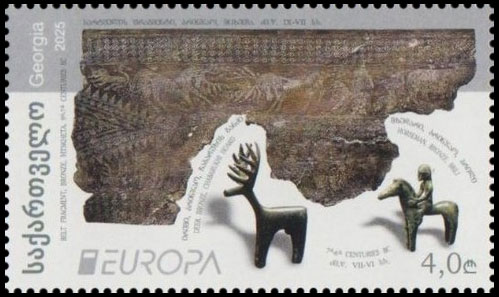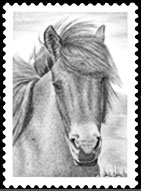
On May 9, 2025, Georgian Post issued a series of postage stamps, "National Archaeological Discoveries," as part of the annual "Europe" project.
Georgia is extremely rich in archaeological sites and traces of ancient cultures. Archaeology reveals unique aspects of the country's ancient history and culture and its connections with neighboring regions.

The two postage stamps in the series, designed by artist Baadur Koblianidze, feature various archaeological finds discovered in Georgia.
The first stamp depicts a fragment of a bronze belt (9th-8th centuries BC) depicting hunting scenes, discovered during excavations in Samtavro (near Mtskheta). The stamp also features two bronze figurines dating to the 7th-6th centuries. BC: a deer from the Chabarukh hoard in the Aragvi River valley and a horseman from Brili (Racha).
The second stamp depicts various clay anthropomorphic figurines characteristic of the Neolithic Shomu-Shulaveri culture (6000 BC), discovered during excavations at the Khrami Didi Gora settlement, as well as ceramic fragments (between 4000 and 3000 BC) discovered in Kiketi.
Excavations in the mountainous region of Racha (Western Georgia) near the villages of Brili and Gebi in the upper reaches of the Rioni River have uncovered numerous archaeological artifacts from the Bronze, Early Iron, and Classical periods. These include ancient burials, weapons, ritual objects, and tools, as well as pottery and bronze jewelry.
Many of the objects found there—weapons (akinakes, axes), bronze figurines of horsemen and animals, and horse harness elements—reflect the cultural contacts of the inhabitants with neighboring regions, particularly Colchis and the steppe nomadic peoples.
The bronze figurine of a horseman found in Brili dates back to the 7th–6th centuries BC. It visually depicts a schematic yet expressive image of a horseman, typical of that era. This ancient figurine once again confirms the important role of the horse in human life, emphasizing the high status of the horseman and equestrian warrior.

The stamps were issued on a miniature sheet with mirror images and artistically designed borders. The artist succeeded in capturing an interesting concept—simple yet rich in information. Ancient artifacts, carefully placed on the stamps, transform them into more than just postal miniatures, but rather museum display cases showcasing fascinating archaeological finds. The "museum" approach to the series is further emphasized by the fact that all the "exhibits" are captioned with dates and brief indications of the archaeological finds' locations.
Перейти в каталог
I apologize for any errors or inaccuracies


